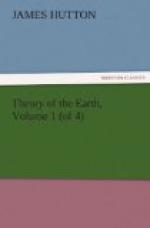Consequently, besides an operation, by which the earth at the bottom of the sea should be converted into an elevated land, or placed high above the level of the ocean, there is required, in the operations of the globe, a consolidating power, by which the loose materials that had subsided from water, should be formed into masses of the most perfect solidity, having neither water nor vacuity between their various constituent parts, nor in the pores of those constituent parts themselves.
Here is an operation of the globe, whether chemical or mechanical, which is necessarily connected with the formation of our present continents: Therefore, had we a proper understanding of this secret operation, we might thereby be enabled to form an opinion, with regard to the nature of that unknown power, by which the continents have been placed above the surface of that water wherein they had their birth.
If this consolidating operation be performed at the bottom of the ocean, or under great depths of the earth, of which our continents are composed, we cannot be witnesses to this mineral process, or acquire the knowledge of natural causes, by immediately observing the changes which they produce; but though we have not this immediate observation of those changes of bodies, we have, in science, the means of reasoning from distant events; consequently, of discovering, in the general powers of nature, causes for those events of which we see the effects.
That the consolidating operation, in general, lies out of the reach of our immediate observation, will appear from the following truth: All the consolidated masses, of which we now inquire into the cause, are, upon the surface of the earth, in a state of general decay, although the various natures of those bodies admit of that dissolution in very different degrees[4]
From every view of the subject, therefore, we are directed to look into those consolidated masses themselves, in order to find principles from whence to judge of those operations by which they had attained their hardness or consolidated state.
It must be evident, that nothing but the most general acquaintance with the laws of acting substances, and with those of bodies changing by the powers of nature, can enable us to set about this undertaking with any reasonable prospect of success; and here the science of Chemistry must be brought particularly to our aid; for this science, having for its object the changes produced upon the sensible qualities, as they are called, of bodies, by its means we may be enabled to judge of that which is possible according to the laws of nature, and of that which, in like manner, we must consider as impossible.
[Note 4: Stalactical and certain ferruginous concretions may seem to form an exception to the generality of this proposition. But an objection of this kind could only arise from a partial view of things; for the concretion here is only temporary; it is in consequence of a solution, and it is to be followed by a dissolution, which will be treated of in its proper place.]




